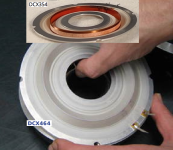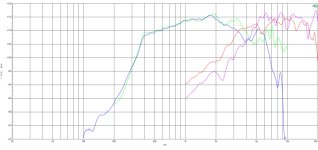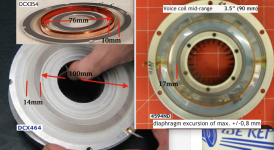Assuming 2 channels per box does the PLD 4.5 have enough juice to drive the 12's to optimal performance?
You may have to try 3 channel mode per box to really open them up.
You may have to try 3 channel mode per box to really open them up.


That's sensitivity though, seeing the 464 has a higher SD and larger voice coil, and midrange will probably be limited by it's excursion won't the DCX354 bottom out way before the 464 when crossed as low? I guess that's why the recommended crossover frequencies for both drivers differ, since otherwise there'd be no way for it to play at the rated power.I've also been closely watching the DCX464 vs DCX354 situation, while i will take B&C's word for it that the 354's MF plays a smaller range, the response graph on the website between the two is extremely similar. Output wise the 354 has the same or better sensitivity with a small sacrifice in total power handling ending up with roughly a max output reduction of .5dB on both the MF and HF sections compared to the 464, seems like a reasonable compromise overall for improved distortion i think (i do wonder how much?). From the postings/updates, it's mentioned there have been several improvements on the design and manufacturing process since the 464 release so i suspect the 354 may be even better than it initially appears.
I know graphs don't always tell the full story but you would think they are almost interchangeable seeing this (manually overlapped images from B&C site):
DCX464 in blue, red
DCX354 in green, purple
View attachment 209679
Unrelated, for those who don't know Australia now has a B&C distributor at surgesound.com.au and from my correspondence with them, the prices are very reasonable compared to previous import options.

Yes, the diaphragm would hammer the phase plug with about 5dB less output at 650Hz in the DCX464 than the DCX354, so the DCX354 may sound distressed while the 12" are still clean.That's sensitivity though, seeing the 464 has a higher SD and larger voice coil, and midrange will probably be limited by it's excursion won't the DCX354 bottom out way before the 464 when crossed as low?
At how strong of a signal do you bash the DCX464's diaphragm into the phase plug in the first place? With a recommended lowest highpass of 300hz for the 464, I assume that you have a whole lot of displacement left if you cross if over at 650hz instead. So much so that you could probably go for a smaller diaphragm and still not bash it. After all, B&C do recommend a lowermost highpass at 400hz for the 354, so there is likely quite a bit of displacement left if you cross over at 650hz.Yes, the diaphragm would hammer the phase plug with about 5dB less output at 650Hz in the DCX464 than the DCX354, so the DCX354 may sound distressed while the 12" are still clean.
I'd guess a little more than what is required to "keep up" with the dual 12" at 650Hz ;^).At how strong of a signal do you bash the DCX464's diaphragm into the phase plug in the first place?
Anyway, if you think the smaller diaphragms in the DCX354 will keep up to the 2x12" in the 650Hz range on the XT1464 horn, go ahead, and report back how they compare when the 12" are reaching 135+dB.
Continuing the family started by our DCX464 coaxial compression driver, the DCX354 features a similar design with smaller dimensions. 76mm (3”) MF coil and 51mm (2”) HF coil ring radiator diaphragms allow the DCX354 to provide very high sound pressure levels above 500Hz, with even lower distortion than its big brother.
It’s going to be about 80% the cost, 80% the diameter, and 80% the weight of the DCX464. Surprisingly not much less output, except <500Hz. Smaller diaphragms are a little better behaved!
It is possible to allow a smaller diaphragm have more displacement by increasing the diaphragm to phase plug distance.I'm pretty tempted to believe it really does perform the same at 650hz; just because it hasn't been possible in the past on a smaller diaphragm doesn't mean it will always be that way.
The BMS 4594 has a 90mm (3.5") voice coil, the diaphragm is slightly wider than the DCX464's.FWIW, the 4594 has a 3" diaphragm and is speced as being good for 1kw peak power above 500hz. The DCX354 does have a higher sensitivity and a more extended MF response than the 4594, indicating a lighter moving mass or a smaller chambre or both, but I'd be surprised if it couldn't handle at least it's program power over 500hz, and more than that above 650hz, excursion wise.

Good input, Art!The BMS 4594 has a 90mm (3.5") voice coil, the diaphragm is slightly wider than the DCX464's.
At 400Hz, the rating drops from 1kw peak to 150W RMS.
View attachment 209681
The reduction in diaphragm area between the 100mm of the B&C DCX464 vs the B&C DCX354 76mm voice coil is significant, the smaller being about half the Sd (diaphragm surface piston area) of the larger. Assuming the same Xmech, there should be just under 6dB difference in displacement limited output.
The difference in Sd is similar to that between an 18” and a 12”.
The hole in the center of an annular diaphragm reduces the Sd in comparison to a dome diaphragm, but larger diaphragm to phase plug spacing is possible with reduced high frequency.
The 100mm diaphragm appears about 14mm wide, an Sd of 3.4 square inches (22 square cm).
The 76mm diaphragm appears about 10mm wide, an Sd 1.84 square inches (11.94 square cm), just over half the displacement assuming the same excursion.
The above computations assume a flat Sd, while the annular diaphragms have a “V” shaped diaphragm cross section, so the Sd would be larger than indicated, but by the same ratio assuming similar “V” angles.
The BMS 4594 drops at around 6.8kHz, slightly higher than the B&C DCX464.
The DCX464 may have more excursion than the BMS 4594’s +/-0.8mm, so could still have more displacement.
Art
If mounted on the same 320Hz exponential horn, yes. The 18 Sound XT1464 cutoff is >500Hz, it's sensitivityGood input, Art!
So, what we have figured so far is that the MF for the 4594 and the DCX464 likely have very similar output when displacement, sensitivity, and power handling are all accounted for.
I'd only be guessing at an answer, and it would depend on the horn.The 4594 is specified to be good for 1kw above 500hz, but only 150w above 400hz. That equals about a 8.5db input difference. How much power should the displacement be good for at 650 hz then? Another 3-6db?
Without knowing the DCX464 and DCX354 Xmax/Xmech, we really don't know the displacement capability.Now lets say that the DCX354 has half the displacement of the other two, which equals a 6db difference in displacement capability.
"Good" is a relative term.Now, testing is what it all comes down to in the end, and this sort of voodoo comparison can only give us rough estimations at best, but even if the rough estimations are off by an order of 3-6db, we should still be good with the DCX354 when crossed at 650hz.
Peter,If you are using the BMS with a passive crossover then an NL4 will work fine. If you are using the BMS 2- way you will need an NL8 ... BMS VHF pins 4,4, BMS HF pins 3,3, mid 12NDL76 pins 2,2, Sub pins 1,1.

